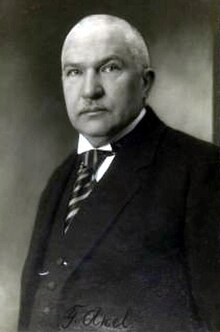Kristlik Rahvaerakond


The Christian People's Party ( Estonian Kristlik Rahvaerakond - KRE) was a conservative political party in Estonia in the interwar period .
History and program
The Christian People's Party emerged as a breakaway movement from the Estonian People's Party ( Eesti Rahvaerakond ) led by Jaan Tõnisson . At the founding congress of the Estonian People's Party in March 1919, shortly before the elections to the Constituent Assembly of the Republic of Estonia ( Asutav Kogu ), the different ideas about the role of the Church in the democratic state came to light. Supporters of a stronger role for the Church split off and founded the Christian People's Party.
The Christian People's Party tried to counteract the dwindling influence of the Evangelical Lutheran Church in state and society. Their supporters represented a decidedly Christian worldview and advocated the strengthening of Christian moral concepts. Its program was close to conservatism and thus remained closely linked to the ideas of the Estonian People's Party. The party had a relatively large influence on cultural and educational policy in Estonia in the 1920s.
In addition to church representatives and theologians such as clergymen Jakob Kukk , Johan Kõpp , Alexander Kapp and Hugo Bernhard Rahamägi , secular politicians also played a major role in the party. The most important were Friedrich Karl Akel (head of government 1924) and the multiple ministers Jaan Lattik , Nikolai Kann and Heinrich Bauer .
The party achieved its greatest success in 1923 with a referendum on the introduction of a state-funded compulsory subject religion in the curriculum of public schools (with voluntary participation of the students). The Estonian parliament had previously rejected the bill. The referendum operated by the party in February 1923 was successful with a majority of 71.9% of the vote. As a result, according to the provisions of the constitution, parliament had to be dissolved and new elections were held. The KRE was able to record a historic election success with 8 mandates.
After the referendum, support for the Christian People's Party continued to decline. Theological disputes within the Estonian Evangelical Lutheran Church also contributed to this, which were carried over to the party. The party became more clerical. From then on, the main focus was less on cultural and educational policy than on the rights and property of the parishes.
In October 1931, the Estonian People's Party and the Christian People's Party, which had separated in 1919, merged again. In January 1932 the National Center Party ( Rahvuslik Keskerakond ) emerged from an association of the Estonian People's Party with the conservative Estonian Labor Party ( Eesti Tööerakond ).
Election results
| choice | Legislative period | be right | MPs (Asutav Kogu = 120 seats) (Riigikogu = 100 seats) |
|---|---|---|---|
| 1919 | Asutav Kogu | 4.4% | 5 |
| 1920 | 1. Riigikogu | 7.2% | 7th |
| 1923 | 2. Riigikogu | 7.3% | 8th |
| 1926 | 3. Riigikogu | 5.4% | 5 |
| 1929 | 4. Riigikogu | 4.1% | 4th |
literature
- Sulev Vahtre (Ed.): Eesti Ajalugu. Volume 6: Vabadussõjast Taasiseseisvumiseni. Ilmamaa, Tartu 2005, ISBN 9985-77-142-7 , p. 66 f.
Individual evidence
- ^ Mati Laur et al .: History of Estonia. 2nd edition. Avita, Tallinn 2002, ISBN 9985-2-0606-1 , p. 229.